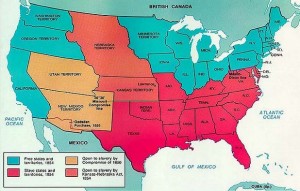Illinois Senator Stephen Douglas, one of the architects of the Compromise of 1850, proposed to organize governments for two new territories that belonged to the Louisiana Purchase Lands, Kansas and Nebraska. His motivation had political and economical roots. He had envisioned a transcontinental railroad crossing the country west to east with Illinois, his state, as the eastern terminal. He needed the support of the south. And because the territory was above the 36˚30’ line of the 1820 Missouri Compromise, the bill would open up territory not previously available to slavery. The bill was approved and signed by President Franklin Pierce.
The Kansas-Nebraska Act drew new borders for Kansas and Nebraska and allowed its citizens to decide the inclusion or exclusion of slavery by popular sovereignty within their boundaries. Northern abolitionists viewed the Act as a provocation, as a betrayal of the North and against the policy of incremental abolitionism. Abolitionist leaders such as Frederick Douglass took a more revolutionary role. The nullification of the 1820 Missouri Compromise led to violent instability and became the most significant turning point on the road to the American Civil War.
The Kansas-Nebraska Act allowed its citizens to decide by popular sovereignty the inclusion of slavery into their territories.
Click on image to enlarge
Nebraska was a more progressive territory where differences were resolved within their more mature political institutions. The opinion of the majority of its settlers was to not extend slavery to Nebraska. In Kansas, on the other hand, the conditions were different. Radicals from both sides, antislavery and pro slavery, rushed to the territory in order to vote in the election that would decide to allow slavery or not. The confrontation started a mini civil war in Kansas known as Bleeding Kansas.
As a result of sectional differences a new party was born, the Republican Party. It emerged as an opposition to the Kansas-Nebraska Act. The Republican Party was made up of members of different parties and its appeal rested on the non-extension of slavery and on the agreement that slavery is morally wrong. Debates between Abraham Lincoln and Stephen Douglas became the most interesting political debates in the country according to the New York Times and the Chicago Tribune.
The Dread Scott Case in March 1857 and the Harper’s Ferry raid in October 1859 further divided the nation. The election of Republican Abraham Lincoln as President served as the last drop in the tensions between regions. Four days after the election results South Carolina seceded from the Union and by the end of 1860, six more southern states joint the newly formed Confederate States of America.
